Oryctes rhinoceros (coconut rhinoceros beetle)
Identity
- Preferred Scientific Name
- Oryctes rhinoceros (Linnaeus)
- Preferred Common Name
- coconut rhinoceros beetle
- Other Scientific Names
- Oryctes stentor Castelnau, 1840
- Scarabaeus rhinoceros Linnaeus
- International Common Names
- EnglishAsiatic rhinoceros beetleblack beetlecoconut black beetlecoconut palm rhinoceros beetledate palm beetledung beetlerhinoceros beetlescarab beetle
- Spanishescarabajo rinoceronte Asiático
- Frenchoryctes du cocotierrhinoceros du cocotier
- Local Common Names
- GermanyIndischer nashornkaefer
- Indonesiakumbang badakkumbang tanduk
- Netherlandsklappertor
- EPPO code
- ORYCRH (Oryctes rhinoceros)
Pictures
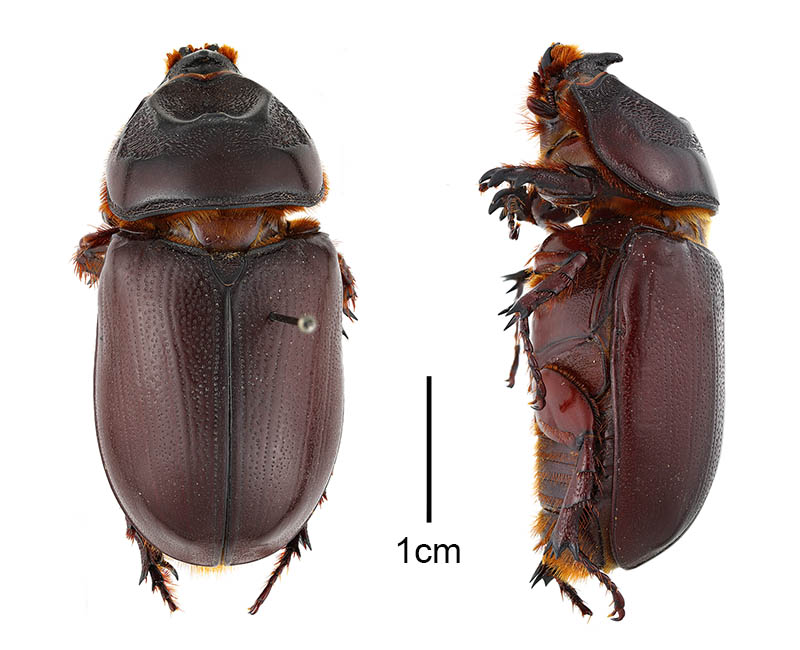
Adults
Oryctes rhinoceros (coconut rhinoceros beetle); adult females, lateral and dorsal views. Collected by J.G. Franclemont in Agoo, La Union, Luzon, Philippine Islands between 11–20 July 1945.
©Hanna Royals/Screening Aids/USDA APHIS PPQ/Bugwood.org - CC BY-NC 3.0 US
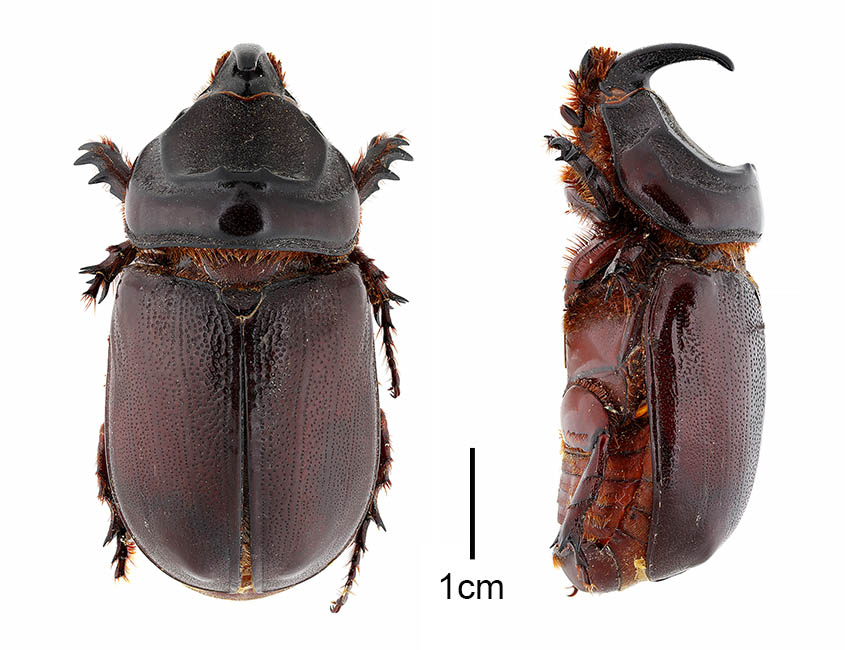
Adults
Oryctes rhinoceros (coconut rhinoceros beetle); adult males, lateral and dorsal views. Collected 20 August 1957 in Thailand (ex-Siam).
©Hanna Royals/Screening Aids/USDA APHIS PPQ/Bugwood.org - CC BY-NC 3.0 US
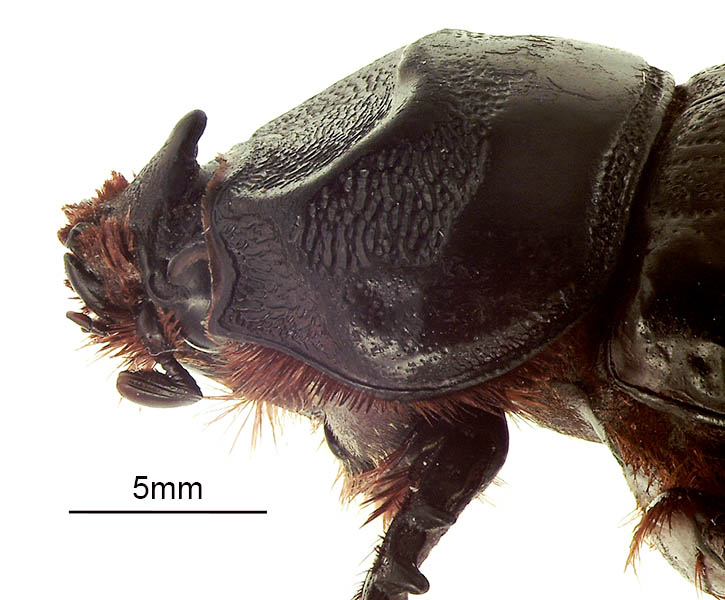
Adult
Oryctes rhinoceros (coconut rhinoceros beetle); adult female, head and pronotum. Pearl Harbor Mil. Base, Hawaii USA. June 2014.
©Emmy Engasser/Hawaiian Scarab ID/USDA APHIS PPQ/Bugwood.org - CC BY-NC 3.0 US
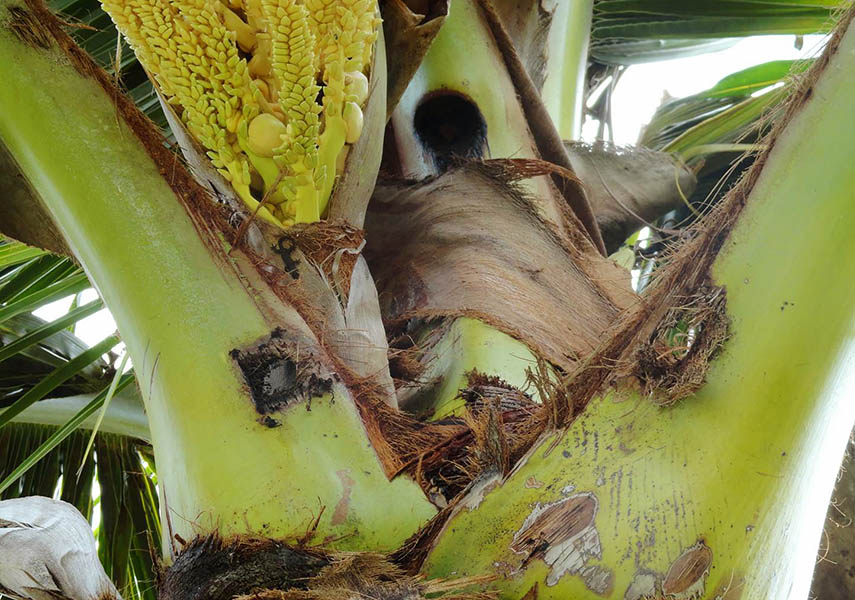
Damage
Oryctes rhinoceros (coconut rhinoceros beetle); damage to coconut fronds. Hawaii, USA. July 2015.
Public Domain - Released by Scot Nelson (original image by Kailee Tam)/via flickr - CC0
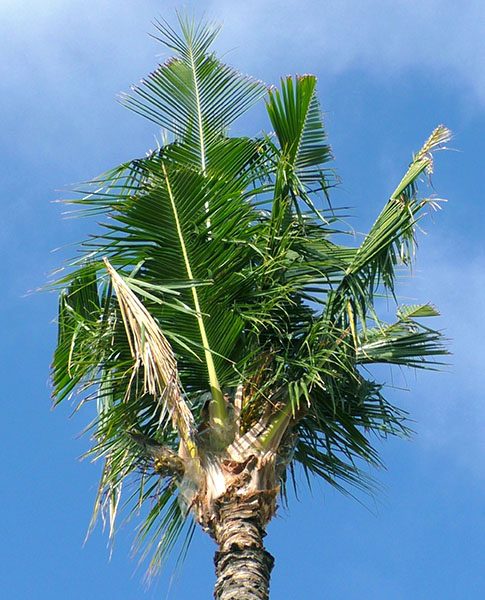
Crown damage
Oryctes rhinoceros (coconut rhinoceros beetle); damage to coconut fronds. Typically, beetle damage produces fronds with wedge-shaped gaps, or the characteristic serrated cut (fan shaped fronds). Hawaii, USA. June 2015.
Public Domain - Released by Scot Nelson (original image by Kailee Tam)/via flickr - CC0
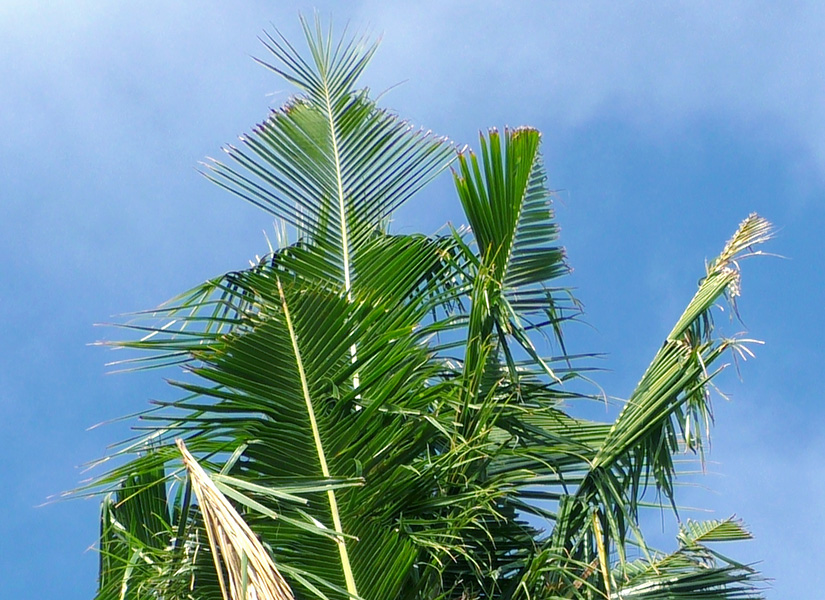
Crown damage
Oryctes rhinoceros (coconut rhinoceros beetle); damage to coconut fronds. Typically, beetle damage produces fronds with wedge-shaped gaps, or the characteristic serrated cut (fan shaped fronds). Hawaii, USA. June 2015.
Public Domain - Released by Scot Nelson (original image by Kailee Tam)/via flickr - CC0
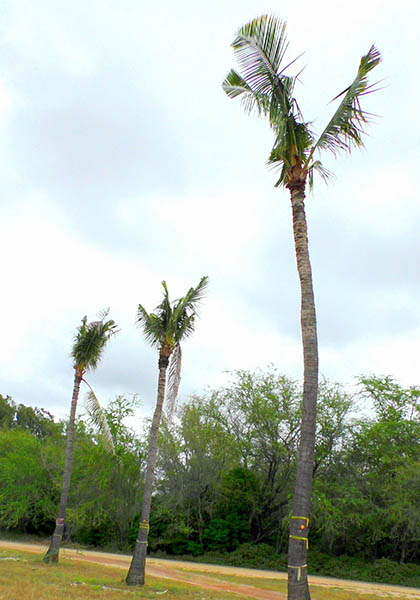
Crown damage
Oryctes rhinoceros (coconut rhinoceros beetle); crown damage to coconut palms. Hawaii, USA. June 2015.
Public Domain - Released by Scot Nelson (original image by Kailee Tam)/via flickr - CC0
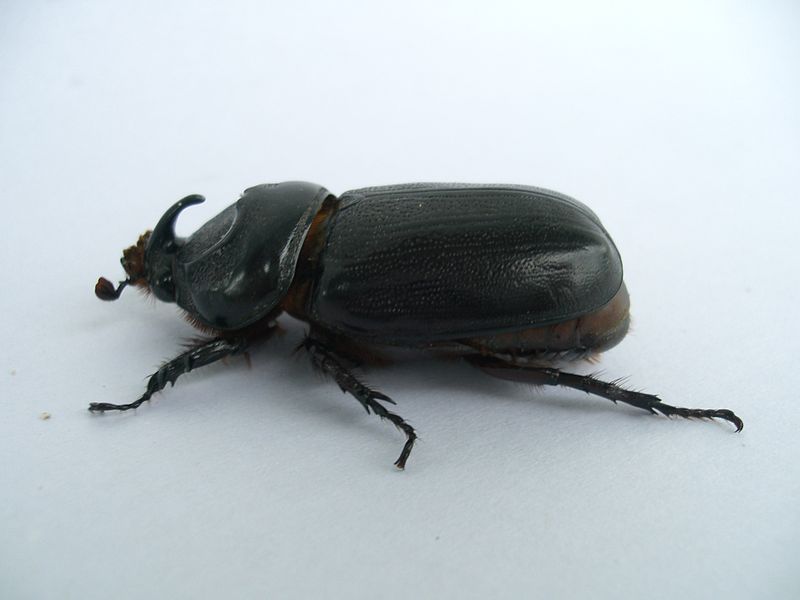
Oryctes rhinoceros
Oryctes rhinoceros side view.
Vitalfranz
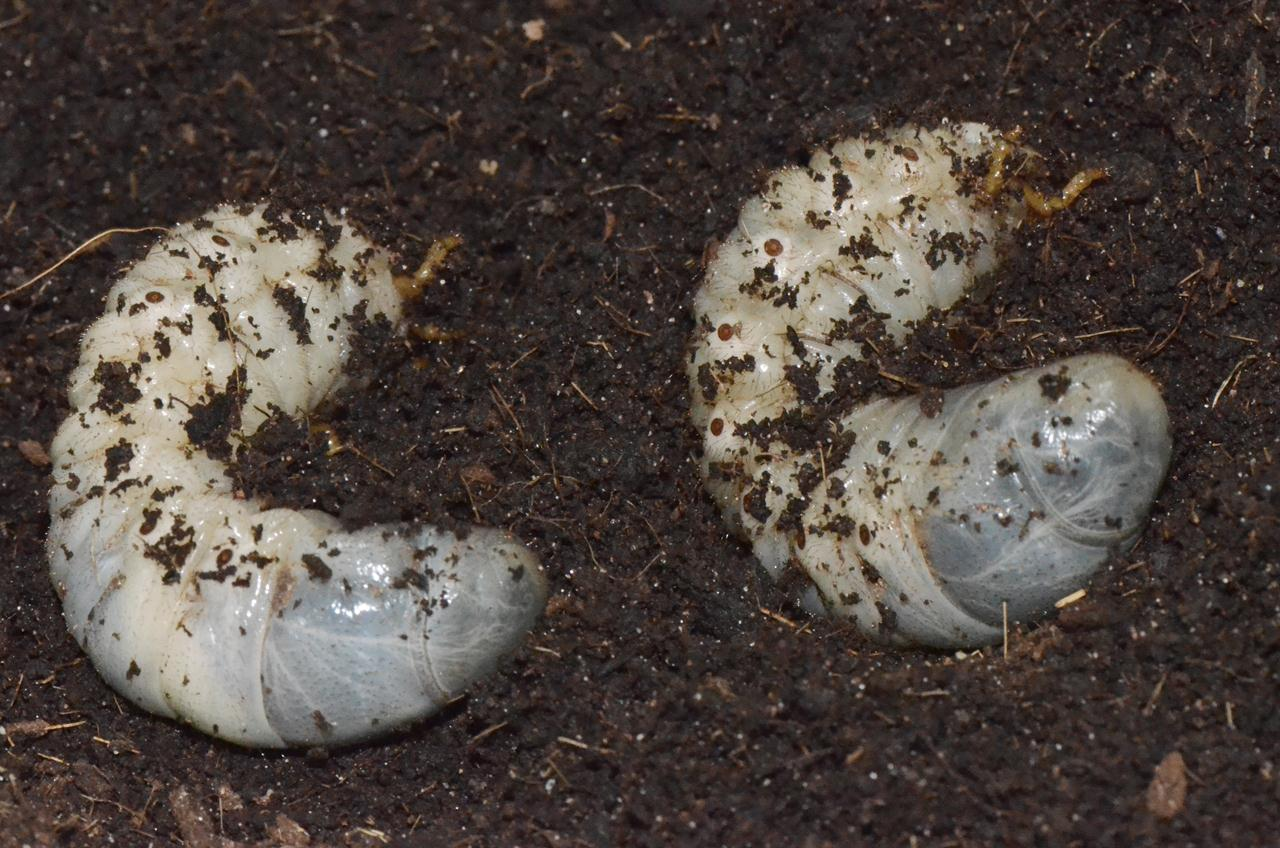
Oryctes rhinoceros
Larvae in soil
NBAIR

Oryctes rhinoceros
Adult
NBAIR
Distribution
Host Plants and Other Plants Affected
| Host | Host status | References |
|---|---|---|
| Agave sisalana (sisal hemp) | Other | |
| Ananas comosus (pineapple) | Other | |
| Areca catechu (betelnut palm) | Main | |
| Carica papaya (pawpaw) | Other | |
| Cocos nucifera (coconut) | Main | Kinawy (2004) Jackson et al. (2022) |
| Colocasia esculenta (taro) | Main | |
| Elaeis guineensis (African oil palm) | Main | Huger (2005) |
| Lantana | Other | |
| Metroxylon sagu (sago palm) | Other | |
| Musa x paradisiaca (plantain) | Other | |
| Pandanus (screw-pine) | Main | |
| Phoenix dactylifera (date-palm) | Main | |
| Saccharum officinarum (sugarcane) | Other | |
| Wodyetia bifurcata (foxtail palm) | Other | |
| Xanthosoma sagittifolium (elephant ear) | Unknown | Cayabyab et al. (2017) |
Symptoms
O. rhinoceros adults feed in the crown region of both coconut and oil palm. On oil palms they bore through petiole bases into the central unopened leaves. This causes tissue maceration and the presence of a fibrous frass inside and at the entrance to the feeding hole is an indication of its activity within (Catley, 1969). A single attack may be followed by others on the same palm (Barlow and Chew, 1970; Young, 1975). These attacks subsequently produce fronds which have wedge-shaped gaps or the characteristic V-shaped cuts to fronds(Wood, 1968a; Sadakathulla and Ramachandran, 1990).
List of Symptoms/Signs
| Symptom or sign | Life stages | Sign or diagnosis |
|---|---|---|
| Plants/Growing point/dead heart | ||
| Plants/Growing point/dieback | ||
| Plants/Growing point/distortion | ||
| Plants/Growing point/internal feeding; boring | ||
| Plants/Leaves/abnormal forms | ||
| Plants/Leaves/internal feeding |
Prevention and Control
Physical Control
A method for trapping adults has been developed and tested by Hoyt (1963) and Bedford (1973). Hoyt (1963) designed a simple, cheap trap, consisting of a piece of coconut trunk, the cap with a beetle-size hole drilled through the centre, and resting on a tin can a tin can placed right below it leaving no space between them. The whole trap is set at a height of 1.8 m from the ground. There was no chemical attractant used in this trap: the decaying trunk served as the attractant. When a small quantity of the synthetic chemical attractant ethyl dihydrochrysanthemumate (chrislure) was applied to the coconut cap of the Hoyt trap, catch was increased (Bedford, 1973) compared to dispensing the lure from a more expensive metal vane-type trap (Barber et al., 1971). Chrislure was subsequently superseded by ethyl chrysanthemumate (rhinolure) (Maddison et al., 1973). Hoyt's trap was used by Bedford (1975) to monitor population trends at a density of 23 traps per 8 hectares. To control beetle infestation, the density of the traps should be increased at the borders of a known source of infestation rather than inside the field (Young, 1972). The use of light traps for controlling populations has been found to be ineffective: Wood (1968a) indicated that beetles do not often enter traps although they are attracted to the light source. However, light traps may be useful for monitoring purposes.
Pheromonal Control
A male-produced aggregation pheromone, ethyl 4-methyloctanoate (E4-MO) was discovered (Hallett et al., 1995; Morin et al., 1996). It has been synthesised and is available commercially (for details of synthesis and types of traps available, see Bedford (2013a)). It is reported to be 10 times more attractive than ethyl chrysanthemumate. The pheromone is stored in a small, heat-sealed, polymer membrane bag and placed between interlocking metal vanes mounted on a plastic bucket. The beetles attracted by the pheromone are trapped inside the bucket. It is very useful as a monitoring tool, and as an economical control method particularly in young oil palm replant areas when placed at one trap per 2 ha (Norman and Basri, 2004; Oeschlager, 2007; Bedford, 2014).
Cultural Control
Sanitation within and surrounding the plantations, especially destruction of the potential or existing breeding sites of this pest, provides an important basis for its control (Wood, 1968a; Turner, 1973). Manure heaps and pits may have to be covered or alternatively turned regularly for the removal of the grubs (Catley, 1969). The establishment of a good, fast-growing ground cover crop provides a vegetative barrier that hampers the movement of the adult beetle looking for suitable breeding sites or young oil palms in replant areas (Wood, 1968b). This restricts the damage in oil palm to low levels (Wood et al., 1973). Removal of the adults from the point of attack in young palms by using a hooked piece of wire (winkling) can be considered a common mechanical control technique to reduce the number of adults in an infested area. This practice is often costly, labour intensive and needs to be conducted regularly, provided that sufficient labour is available. However, some additional damage may be inflicted to the young palms during the search for the adults, making the practice not entirely satisfactory.
Biological Control
Early attempts at biological control of O. rhinoceros concentrated on the introduction of predators and scoliid parasitoids of other Oryctes species mainly from Africa. None of those that became established was able to provide satisfactory control. However, biological control effort concentrated on Oryctes rhinoceros nudivirus (OrNV) after its discovery in Malaysia in 1965 (Huger, 1966) and its successful introduction into Western Samoa in 1967 (Swan, 1974; Waterhouse and Norris, 1987). Endemic natural enemies of O. rhinoceros offer a cheap and long-term control of the pest, leading to a reduction in the use of chemical insecticides. OrNV and the pathogenic fungus Metarhizium anisopliae have been utilized further for field control of this pest in several countries (George and Kurian, 1971; Latch and Falloon, 1976; Zelazny, 1979b; Bedford, 1986; Darwis, 1990). For OrNV, the adult beetles are dipped in a suspension of ground, infected grubs. They are then allowed to crawl about for 24 hours through sterilized sawdust mixed with the above suspension. They are then released back into the plantation to infect other adults and larvae in the breeding sites (Bedford, 1976d). OrNV suspension may also be applied directly to the mouthparts of adults to infect them for release (Ramle et al., 2005). A supply of beetles for infecting and release may be obtained from a mass-rearing facility. The fungus Metarhizium anisopliae var. major may be produced commercially or in bulk by various methods, for release by suitable means into breeding sites, particularly into chipped decaying oil palm trunk material in oil palm replant areas (Sivapragasam and Tey, 1995; Tey and Ho, 1995; Ramle et al., 1999, 2006, 2007, 2009, 2011; Ramle and Kamarudin, 2013).
Chemical Control
Due to the variable regulations around (de-)registration of pesticides, we are for the moment not including any specific chemical control recommendations. For further information, we recommend you visit the following resources:
•
EU pesticides database (http://ec.europa.eu/food/plant/pesticides/eu-pesticides-database/)
•
PAN pesticide database (www.pesticideinfo.org)
•
Your national pesticide guide
Impact
On oil palms, O. rhinoceros bores into the base of the cluster of unopened leaves (spears), causing V- or wedge-shaped cuts in the unfolded fronds. Spears may collapse or emerged fronds may break off along the petiole or midrib (Wood, 1968). In young palms where the spears are narrower and penetration may occur lower down, the effects of damage can be much more severe than in older palms (Wood, 1968a). The young palms affected by the beetle damage are believed to have a delayed immaturity period (Liau and Ahmad, 1991). Thus, early oil palm yields could be considerably reduced after a prolonged and serious rhinoceros beetle attack. Although Wood et al. (1973) suggested that the damage to the immature palms results in relatively small crop losses, field experiments conducted by Liau and Ahmad (1991) revealed an average of 25% yield loss over the first 2 years of production. This was possibly caused by the reduction in the canopy size of more than 15% for moderately serious to higher damage levels (Samsudin et al., 1993). In India, the infestation in oil palm was more prevalent in mature plantations (10-15 year old) compared to immature or younger plantings (Dhileepan, 1988).
Similarly, on coconut the reduction in leaf area of the palms influences nut production (Zelazny, 1979a) but the attack was more towards the tall, mature trees, from about 5 years of age onwards (Bedford, 1976c). Serious attacks on coconut may be observed in areas adjacent to a breeding site with a high beetle population, especially in the coastal region of Peninsular Malaysia. Zelazny (1979a) reported an average of 10% of fronds damaged by cuts resulted in a 3% reduction of the leaf area and a 4-5% loss of nut production; similarly 30% of fronds damaged resulted in a 7% reduction of the leaf area and 13% nut yield reduction, i.e. loss.
Similarly, on coconut the reduction in leaf area of the palms influences nut production (Zelazny, 1979a) but the attack was more towards the tall, mature trees, from about 5 years of age onwards (Bedford, 1976c). Serious attacks on coconut may be observed in areas adjacent to a breeding site with a high beetle population, especially in the coastal region of Peninsular Malaysia. Zelazny (1979a) reported an average of 10% of fronds damaged by cuts resulted in a 3% reduction of the leaf area and a 4-5% loss of nut production; similarly 30% of fronds damaged resulted in a 7% reduction of the leaf area and 13% nut yield reduction, i.e. loss.
Information & Authors
Information
Published In
Copyright
Copyright © CABI. CABI is a registered EU trademark. This article is published under a Attribution-NonCommercial-NoDerivatives 4.0 International (CC BY-NC-ND 4.0)
History
Published online: 9 October 2023
Language
English
Authors
Metrics & Citations
Metrics
SCITE_
Citations
Export citation
Select the format you want to export the citations of this publication.
EXPORT CITATIONSExport Citation
View Options
View options
Get Access
Login Options
Check if you access through your login credentials or your institution to get full access on this article.


